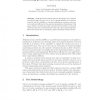Free Online Productivity Tools
i2Speak
i2Symbol
i2OCR
iTex2Img
iWeb2Print
iWeb2Shot
i2Type
iPdf2Split
iPdf2Merge
i2Bopomofo
i2Arabic
i2Style
i2Image
i2PDF
iLatex2Rtf
Sci2ools
IDEAL
2005
Springer
2005
Springer
Generating Predicate Rules from Neural Networks
Artificial neural networks play an important role for pattern recognition tasks. However, due to poor comprehensibility of the learned network, and the inability to represent explanation structures, they are not considered sufficient for the general representation of knowledge. This paper details a methodology that represents the knowledge of a trained network in the form of restricted first-order logic rules, and subsequently allows user interaction by interfacing with a knowledge based reasoner.
| Added | 27 Jun 2010 |
| Updated | 27 Jun 2010 |
| Type | Conference |
| Year | 2005 |
| Where | IDEAL |
| Authors | Richi Nayak |
Comments (0)

